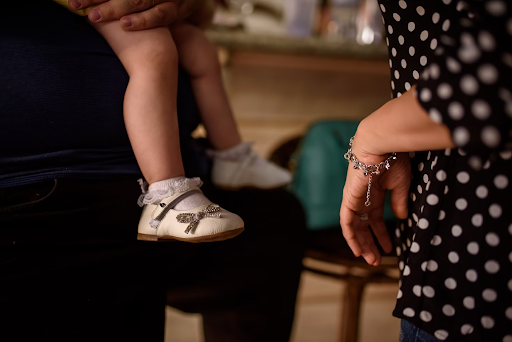The stress of a separation is overwhelming enough. When you add a fundamental disagreement over the care and custody of your children, that stress can feel unbearable. You’re facing a future filled with uncertainty, driven by the fear that you might not get the time with your children that you know is right. You’re asking yourself, “What do you do when you and your ex fundamentally disagree on what’s best for our children?”
It’s a frustrating and frightening position to be in, but it’s important to know that a destructive courtroom battle is not a foregone conclusion. In fact, most parents find a way forward without a judge making the final call. As LegalJobs data shows, “parents settle 90% of child custody disputes without a judge’s ruling.” The good news is that you are not without a map. Understanding the formal processes, your legal rights, and the various paths to resolution is the first step toward regaining control and stability..
Key Takeaways
- Most child custody disputes (90%) are settled outside of court through Alternative Dispute Resolution (ADR) methods like mediation or collaborative law.
- When court intervention is necessary, decisions are made solely based on the “best interests of the child,” considering factors like parental stability, health, and emotional ties.
- Proactive preparation, including detailed documentation and a child-focused mindset, is crucial for both negotiations and litigation.
- Seeking expert legal guidance is essential to understand your rights and navigate complex custody laws effectively, regardless of the path chosen.
Understanding Your Primary Options
When you and your co-parent reach an impasse on custody, you arrive at a fork in the road. Every disputed case proceeds down one of two main paths: a collaborative route focused on resolution or a formal route that ends in a judge’s decision. Understanding these two paths is the first step in making an informed choice about how to proceed.
Path 1: Alternative Dispute Resolution (ADR) – The Collaborative Route
Alternative Dispute Resolution, or ADR, refers to any method used to resolve a legal dispute without going to trial. This is the path that the vast majority of parents take. It is generally faster, less expensive, and far less adversarial than litigation. ADR empowers you and your ex to create a customized parenting plan that works for your unique family, rather than having a one-size-fits-all solution imposed by a court. The most common forms of ADR in family law are mediation and collaborative law.
Path 2: Litigation – The Court-Ordered Route
Litigation is the formal legal process where you ask a judge to hear your case and make legally binding decisions about custody and visitation. This path becomes necessary when communication has completely broken down, in high-conflict situations, or when there are serious concerns about a child’s safety, such as domestic violence or substance abuse. While it provides a definitive resolution, litigation can be lengthy, costly, and emotionally draining, and it removes the final decision-making power from your hands.
When court involvement becomes unavoidable, having an experienced Orange County Child Custody Attorney can make a critical difference. A qualified lawyer guides parents through each stage of litigation—from filing motions and preparing evidence to representing their interests before the judge. Beyond legal advocacy, they help ensure that custody arrangements reflect the child’s well-being while protecting parental rights within California’s family law framework.
Choosing the Right Collaborative Path: A Breakdown of ADR Methods
Mediation: Guided Negotiation
Mediation is a structured negotiation process where a neutral third-party professional, the mediator, helps you and your ex communicate effectively. The mediator’s job is not to make decisions or take sides but to facilitate a productive conversation, identify areas of agreement, and help you brainstorm solutions.
Pros: Mediation is completely confidential, generally more cost-effective than other options, and less adversarial. It gives parents ultimate control over the outcome, helping to preserve a functional co-parenting relationship for the future.
Collaborative Law: A Team-Based Approach
Collaborative law is a more structured ADR process. You and your ex each hire your own attorney who has been specially trained in collaborative practice. All four of you sign a participation agreement, committing to resolving all issues without going to court. The process involves a series of meetings with all parties present, often including neutral professionals like child specialists or financial planners, to foster open communication and creative problem-solving. If either party decides to go to court, both collaborative attorneys must withdraw from the case.
Pros: This team-based approach provides built-in legal and emotional support. The commitment to stay out of court incentivizes everyone to find creative, mutually agreeable solutions.
Arbitration: A Private Judge
Arbitration is a more formal process that functions like a private trial. You and your co-parent agree to hire a private arbitrator—often a retired judge or a highly experienced family law attorney—to hear evidence and arguments from both sides. The arbitrator then makes a decision that is legally binding, just as a judge’s order would be.
Pros: Arbitration is typically faster and more private than the public court system. It also allows you to choose your decision-maker and have more control over the scheduling of hearings.
What to Expect When You Go to Court
When ADR is not possible, the court system provides a structured path to a final resolution. While it can be intimidating, understanding the litigation process can help you feel more prepared and in control.
The process generally follows these steps:
- Filing a Petition: One parent initiates the case by filing formal legal documents with the court, asking a judge to make custody orders.
- Temporary Orders: Early in the case, a judge will often make temporary custody and visitation orders to provide stability for the children while the case is ongoing.
- Discovery & Evaluations: This is the information-gathering phase. It can involve exchanging documents, and in some cases, the court may order a child custody evaluation where a mental health professional assesses the family and makes recommendations.
- Hearings & Trial: If you cannot reach an agreement, your case will proceed to hearings or a trial. You and your attorney will present evidence, call witnesses, and make arguments to the judge, who will then issue a final, legally binding ruling.
The Deciding Factor: The “Best Interests of the Child” Standard
A judge’s decision is not based on who is the “better” parent or what the parents want. The court uses a single legal standard: the best interests of the child. This framework forces the focus away from parental rights and squarely onto the child’s health, safety, and well-being.
Key factors a court considers include:
- The child’s age, health, and emotional ties to each parent.
- Each parent’s ability to provide a stable, safe home and consistent care.
- The history of cooperation (or conflict) between the parents.
- Any history of domestic violence, abuse, or substance abuse by either parent.
- The child’s preference, if they are of sufficient age and maturity to express one.
- The importance of maintaining continuity in the child’s routine, school, and community ties.
Navigating a separation is a reality for many families. As family law statistics from the Census Bureau indicate, “over one-quarter of all children under 21 have a parent living outside their household,” normalizing this family structure. Historically, custody decisions often favored one parent. For example, “nationwide, mothers constitute about 79.9% of custodial parents, according to the U.S. Census Bureau.” However, California courts now operate under a policy of promoting frequent and continuing contact with both parents, provided it is in the child’s best interest.
Conclusion
Disagreements over child custody are deeply personal and stressful, but a destructive court battle is not your only option. ADR methods offer powerful, collaborative tools to help you and your co-parent craft a parenting plan that works for your family. Even if litigation becomes unavoidable, the court’s process is guided by the singular goal of protecting your child’s well-being.
The path forward may seem daunting, but you have options. By staying informed, preparing diligently, and focusing on your child’s needs, you can take strategic steps toward achieving a durable parenting plan that allows your child to thrive.








